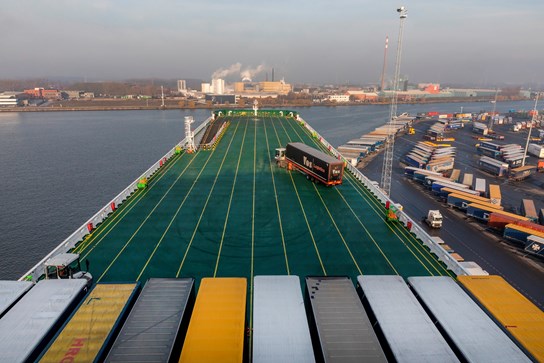Reduced cargo transhipment for North Sea Port in 2023 due to changing geopolitics and the European economy
The year 2022 was the best year ever, on the one hand due to growth and on the other due to the building of additional stocks in the light of exceptional geopolitical and economic conditions such as the Ukraine-Russia war and the energy crisis. It was therefore a near certainty that cargo transhipment would fall in 2023.
Bulk port
North Sea Port has traditionally been a bulk port; this remained true in 2023. However, the shares of both dry bulk and liquid bulk fell by 1%.
Dry bulk again accounted for more than half of cargo transhipment in 2023: 53% (35.2 million tons, -12% compared to 2022). The decline was seen mainly in coal (-27%). However, 2022 was a very exceptional year due to imports of additional stocks following EU sanctions on Russian coal after August 2022. Iron ore, gypsum, cement, wood pellets and natural fertilisers also fell.
Liquid bulk accounted for a share of 23% (15.1 million tons, -14%). Declines were recorded in liquid petroleum fuels (biodiesel and diesel) and naphtha.
The share of breakbulk was 15% (9.6 million tons, -5%). The transhipment of cellulose, in particular, declined.
It is notable that the share of containers in total cargo throughput has remained consistent since 2019 at 3% (2.2 million tons, -6%).
The roll on/roll off (ro/ro) segment saw a slight increase, accounting for 6% of total maritime transhipment (3.8 million tons, +1%).
Expressed by commodity type, there was no change in the transhipment of food products, metal industry products, vehicles and machinery. Declines were recorded in solid fuels (-22%, including coal), chemicals (-18%), agricultural products (-15%), crude minerals/construction materials (-12%), petroleum products (-10%) and fertilisers (-5%).
United States top trading partner
As in 2022, the United States was the port's most important trading partner (5.4 million tons). Although trade with the country declined by 13%, it had grown by more than a quarter in 2022. Great Britain occupied second place (4.7 million tons, -9%) and Brazil third (4.5 million tons, -8%), followed by Canada, Sweden, Russia, Norway, Finland, Australia and France.
As a result of EU sanctions, trade with Russia declined further by -42%, with the country dropping from second place to sixth. In 2022, trade with Ukraine had already halved; in 2023, it halved again.
Europe accounted for 56% of trade with North Sea Port (-1%), South America for 15% (+1%) and North America for 14% (-1%), with Africa at 7% (unchanged), Asia at 4% (unchanged) and Oceania also at 4% (+1%).
In 2023, the import-export ratio was 71%-29% (in 2022 it was 72-28%).
Daan Schalck, CEO North Sea Port: "After the bumper 2022, the impact of wars, the energy crisis and higher commodity prices has been leaving its mark for the past year. In the aftermath of the Brexit and the pandemic, cargo throughput bounced back unexpectedly strongly. Unfortunately this has not been the case with the current crises, at least so far."
Inland shipping positive for container, ro/ro and breakbulk transport
Inland waterway transhipment is impacted less by changes in the global situation. Throughput for this modality reached 61.5 million tons in 2023, which represents a drop of (only) 5% (3.1 million tons) compared to 2022, which was the second record year in a row for inland navigation.
On a positive note, container transhipment via inland waterways was up 40% to 2.6 million tons. Efforts to promote inland navigation were unaffected by economic and geopolitical developments. Also worthy of note is roll on/roll off transhipment, which doubled to 0.1 million tons compared to the previous year's figure of 50,000 tons, which was close to the long-term average. And breakbulk also rose further, by 21% to 4.2 million tons, off the back of a 40% increase in 2022.
Conversely, liquid bulk shrank by 7% to 32.4 million tons and dry bulk by 8% to 22.2 million tons.
The import-export ratio remained unchanged at 41-59%.
Lasting impact
With a seaborne transhipment volume of 65.9 million tons and 61.5 million tons of cargo transhipped via inland navigation, North Sea Port recorded a total transhipment of 127.4 million tons in 2023, compared to 138.1 million tons in 2022. That equals 10.7 million tons less throughput compared to the record year 2022.
Throughout 2023, reduced global demand, rising energy prices and geopolitical tensions in Europe and the Middle East made themselves felt in North Sea Port's cargo throughput. This impact was already noticeable halfway through last year and was confirmed after nine months and now again after one year. There are currently few signs that the situation will change soon.




